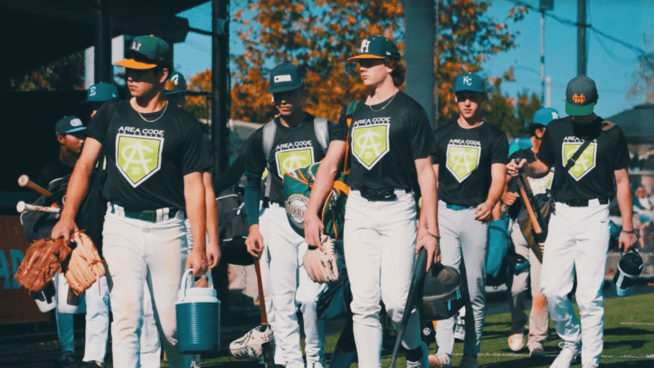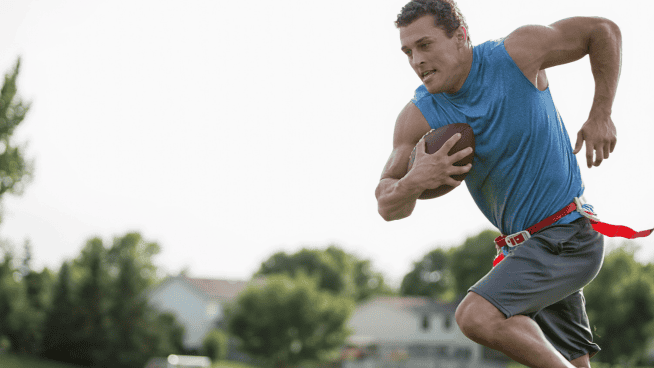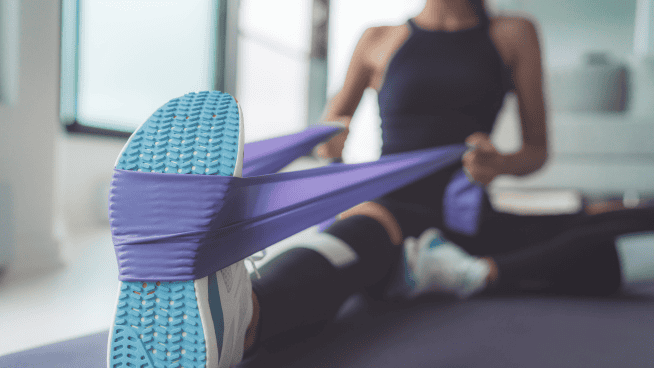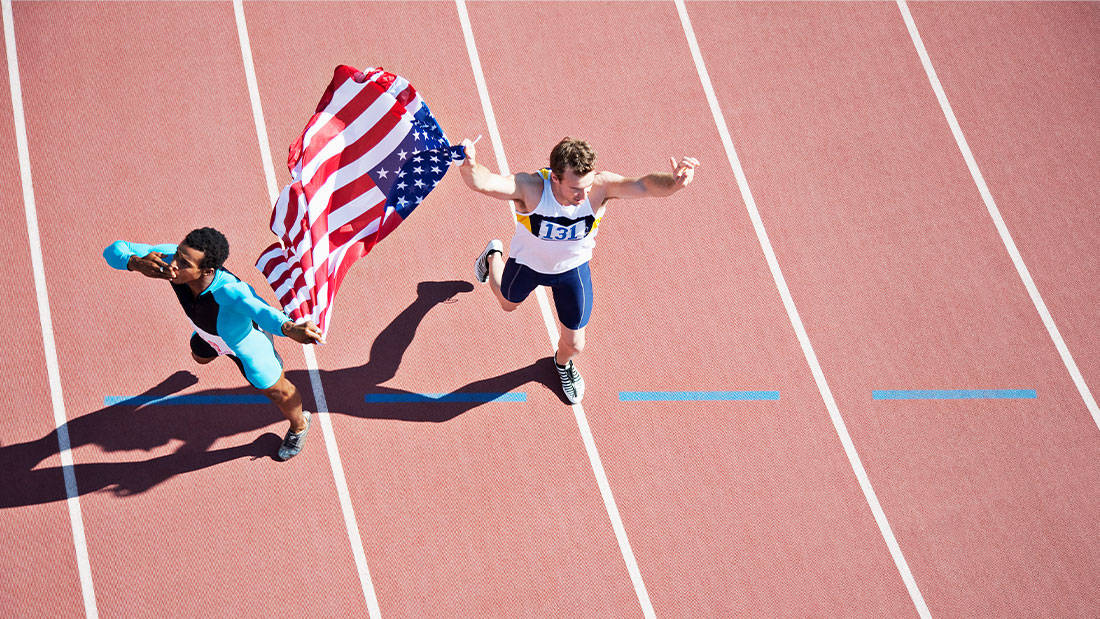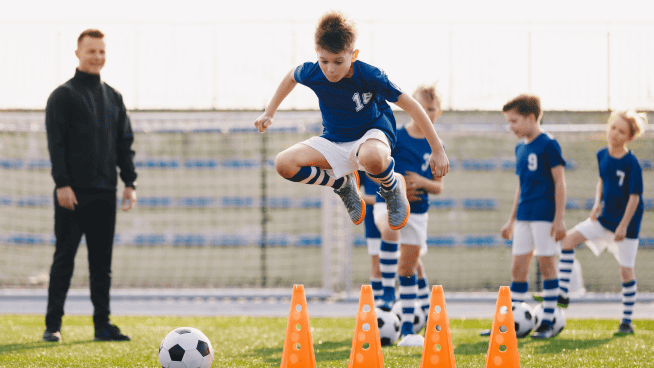How to Build Maximal Strength, the True Measure of Brute Force
![]()
Maximal strength and sports might not seem to go hand in hand. We always talk about explosive power being the key to athleticism. But at the heart of explosive power is maximal strength.
Simply put, maximal strength refers to a muscle’s ability to produce force regardless of how much time it takes. An example of maximal strength is performing a one-rep max test on the Bench Press. You might struggle to complete the rep, and the bar might move slowly or even pause for a moment. But if you complete the rep, you just found out the maximal strength in the muscles involved in the Bench Press.
It’s truly a measure of brute force.
RELATED: The Differences Between Strength and Power Training
OK, so athletes need to be fast. However, you need to look a bit further at the definition of power:
- Power = Force x Time.
Training to increase maximal strength builds the foundation of power by increasing the force variable in the power equation. A stronger muscle can produce more force. The time equation also needs to be improved with plyometrics and explosive movements.
But when it comes down to it, it all starts with maximal strength.
It impacts sprinting, jumping, throwing, hitting, batting, kicking, stopping, changing directions and moving opponents. In other words, it impacts just about every movement performed in sports. It’s a physical ability, but it’s also a skill that has to be practiced.
This article offers some tips about strength training, several must-do exercises and sample programs you can use in your own training.
RELATED: Why Youth Athletes Need to Focus On Strength to Improve Speed
Things to keep in mind:
- You need to train strength yearround, not just six weeks before the season.
- Strength should be built in a total body workout because that’s how you play sports.
- Training for strength means heavy weight, few repetitions and lots of rest in between sets.
- With heavy weights, proper technique helps keep you safe.
- Strength should be the only thing you train in the weight room that day. Be focused.
There are several types of exercises every athlete should include in his or her strength program—Squats, Hip Extensions, Presses, Pulls, Kettlebell Swings and sled work.
- Squats teach you to use your entire body to exert force against the ground. They do this in a manner that is similar to many sports movements. They also work nearly every muscle in your body in one manner or another. They are an important exercise for most athletic movements.
- Hip Extensions are another way to train exerting force against the ground. Unlike Squats, they focus more on the hamstrings, glutes and lower back, which make them really important for sprinting and throwing. These include exercises like Deadlifts and Good Mornings.
- Presses train the upper body to push things away. This is important when you have to move opponents or throw things. Presses can be done with barbells, dumbbells and kettlebells. They can be done with bands or chains added. They include Bench Presses, Incline Presses, Decline Presses, Military Presses and Kettlebell Presses.
- Pulls develop the muscles of the back, shoulder and biceps. It is important to include them to compensate for Presses, otherwise imbalances of the shoulder could develop. These include Bent Over Rows, Dumbbell Rows, Pull-Ups and Pull-Downs.
- Kettlebell Swings are often overlooked as a strength builder, but they can be done with heavy weight and few repetitions. They do not have to be a conditioning exercise. They train nearly every muscle of the body, require the exertion of force against the ground, and train you to exert force in a horizontal direction, which few exercises do. This is very important for sprinting, throwing and kicking. This is a great exercise to begin a total-body strength workout.
- Pulling and pushing a sled are also important for training most of the muscles of the body and for training the ability to exert force horizontally. They are a great way to finish a total-body strength workout.
How To Build Maximal Strength Year-round
Most strength and conditioning programs divide the year up as follows:
- Early off-season: the “get in shape” phase.
- Late off-season: the phase when we are peaking our strength.
- Pre-season: Scrimmages, pre-season games; we are usually ramping up our power development, speed and agility.
- In-season: These are the games that matter. We are trying hard to train enough to maintain everything we’ve developed to this point.
The rest of the article offers workouts that you should be doing in each phase of a strength and conditioning program.
RELATED: How Many Sets and Reps Should You Really Do?
Early off-season
In this phase you should be training total-body strength once a week. I like to do this on Mondays. Keep in mind that when it says something like: 3×4-8@80-90%, the intent is for the weights to increase over the duration of the early off-season so that they are reaching 90% towards the end:
- Kettlebell Swings: 3×4-8
- Back Squats: 3×4-8@80-90%
- Romanian Deadlifts: 3×4-8
- Bench Press: 3×4-8@80-90%
- Bent-Over Rows: 3×4-8
- Military Press; 3×4-8
- Sled Push: 3×20 meters
Late off-season
In this phase, strength should be trained twice a week. I also like to introduce wave loading with one or two exercises. Wave loading involves moving up in weight from sets one to three, then backing off in set four, then moving up in sets five and six. It’s very intense and should not be done for more than four or five weeks.
Day 1 (Monday):
- Kettlebell Swings: 3×3-5
- Front Squats: 3×3-5@85-95%
- Deadlifts: 3×3-5@85-95%
- Bench Press: 1×8@80%, 1×4-6@85%, 1×1-3@90%, 1 x [email protected]%, 1×[email protected]%, 1×1-2@ 92.5%
- One-Arm Dumbbell Rows: 3×3-5 each arm
- Kettlebell Press: 3×3-5 each arm
- Sled Push: 3×40 meters
Day 2 (Thursday):
- One-Arm Kettlebell Swings: 3×3-5 each arm
- Back Squats: : 1×8@80%, 1×4-6@85%, 1×1-3@90%, 1 x [email protected]%, 1×[email protected]%, 1×1-2@ 92.5%
- Good Mornings: 3×3-5
- Seated Dumbbell Shoulder Press: 3×3-5
- Sled Pulls: 3×40 meters
Pre-season
During this phase, it’s a great idea to introduce pause and eccentric variations of some exercises to help bridge the gap between pure strength and pure power. Total body strength work should be cut back to one day a week and might look something like this:
- Kettlebell Swings: 3×4-6
- Pause Back Squats: 3×3-5@70-80% of Back Squat
- Deadlifts from knee height: 3×3-5@85-95%
- Eccentric Bench Press: 3×2-4@70-80% of Bench Press
- Kettlebell Rows: 3×3-5 each arm
- Standing Military Press: 3×3-5
In-season
During the in-season, total body strength training is typically paired with power movements to save training time. As a result, you train one to two times per week depending upon your schedule. Two is better, but one works if necessary.
Day 1 (Monday):
- One-Arm Kettlebell Swings + Standing Long Jump: 3×3-5 each arm + 5 Jumps
- Front Squats and Split Jerk: 3×3-5 Squats + 2-4 Jerks @75-85% of Split Jerk
- Romanian Deadlift and Medicine Ball Throws: 3×3-5 RDLs+5 Throws
- Pause Bench Press and Clapping Push-Ups: 3×3-5 Presses @80-90% +10 Push-Ups
- Sled Pulls: 3×40 meters
Day 2 (Thursday):
- Kettlebell Swings + Mini-Hurdle Hop: 3×3-5 + 5 yards
- Clean-Grip Deadlift and Power Cleans: 3×4-6 Deadlifts and 2-3 Cleans @75-85% of Power Clean
- Back Squats and Vertical Jumps: 3×3-5@80-90% Squats + 5 Jumps
- Bent-Over Rows and Medicine Ball Throws: 3×3-5 Rows + 5 Throws
- Sled Pushes: 3×40 meters
RECOMMENDED FOR YOU
MOST POPULAR
How to Build Maximal Strength, the True Measure of Brute Force
![]()
Maximal strength and sports might not seem to go hand in hand. We always talk about explosive power being the key to athleticism. But at the heart of explosive power is maximal strength.
Simply put, maximal strength refers to a muscle’s ability to produce force regardless of how much time it takes. An example of maximal strength is performing a one-rep max test on the Bench Press. You might struggle to complete the rep, and the bar might move slowly or even pause for a moment. But if you complete the rep, you just found out the maximal strength in the muscles involved in the Bench Press.
It’s truly a measure of brute force.
RELATED: The Differences Between Strength and Power Training
OK, so athletes need to be fast. However, you need to look a bit further at the definition of power:
- Power = Force x Time.
Training to increase maximal strength builds the foundation of power by increasing the force variable in the power equation. A stronger muscle can produce more force. The time equation also needs to be improved with plyometrics and explosive movements.
But when it comes down to it, it all starts with maximal strength.
It impacts sprinting, jumping, throwing, hitting, batting, kicking, stopping, changing directions and moving opponents. In other words, it impacts just about every movement performed in sports. It’s a physical ability, but it’s also a skill that has to be practiced.
This article offers some tips about strength training, several must-do exercises and sample programs you can use in your own training.
RELATED: Why Youth Athletes Need to Focus On Strength to Improve Speed
Things to keep in mind:
- You need to train strength yearround, not just six weeks before the season.
- Strength should be built in a total body workout because that’s how you play sports.
- Training for strength means heavy weight, few repetitions and lots of rest in between sets.
- With heavy weights, proper technique helps keep you safe.
- Strength should be the only thing you train in the weight room that day. Be focused.
There are several types of exercises every athlete should include in his or her strength program—Squats, Hip Extensions, Presses, Pulls, Kettlebell Swings and sled work.
- Squats teach you to use your entire body to exert force against the ground. They do this in a manner that is similar to many sports movements. They also work nearly every muscle in your body in one manner or another. They are an important exercise for most athletic movements.
- Hip Extensions are another way to train exerting force against the ground. Unlike Squats, they focus more on the hamstrings, glutes and lower back, which make them really important for sprinting and throwing. These include exercises like Deadlifts and Good Mornings.
- Presses train the upper body to push things away. This is important when you have to move opponents or throw things. Presses can be done with barbells, dumbbells and kettlebells. They can be done with bands or chains added. They include Bench Presses, Incline Presses, Decline Presses, Military Presses and Kettlebell Presses.
- Pulls develop the muscles of the back, shoulder and biceps. It is important to include them to compensate for Presses, otherwise imbalances of the shoulder could develop. These include Bent Over Rows, Dumbbell Rows, Pull-Ups and Pull-Downs.
- Kettlebell Swings are often overlooked as a strength builder, but they can be done with heavy weight and few repetitions. They do not have to be a conditioning exercise. They train nearly every muscle of the body, require the exertion of force against the ground, and train you to exert force in a horizontal direction, which few exercises do. This is very important for sprinting, throwing and kicking. This is a great exercise to begin a total-body strength workout.
- Pulling and pushing a sled are also important for training most of the muscles of the body and for training the ability to exert force horizontally. They are a great way to finish a total-body strength workout.
How To Build Maximal Strength Year-round
Most strength and conditioning programs divide the year up as follows:
- Early off-season: the “get in shape” phase.
- Late off-season: the phase when we are peaking our strength.
- Pre-season: Scrimmages, pre-season games; we are usually ramping up our power development, speed and agility.
- In-season: These are the games that matter. We are trying hard to train enough to maintain everything we’ve developed to this point.
The rest of the article offers workouts that you should be doing in each phase of a strength and conditioning program.
RELATED: How Many Sets and Reps Should You Really Do?
Early off-season
In this phase you should be training total-body strength once a week. I like to do this on Mondays. Keep in mind that when it says something like: 3×4-8@80-90%, the intent is for the weights to increase over the duration of the early off-season so that they are reaching 90% towards the end:
- Kettlebell Swings: 3×4-8
- Back Squats: 3×4-8@80-90%
- Romanian Deadlifts: 3×4-8
- Bench Press: 3×4-8@80-90%
- Bent-Over Rows: 3×4-8
- Military Press; 3×4-8
- Sled Push: 3×20 meters
Late off-season
In this phase, strength should be trained twice a week. I also like to introduce wave loading with one or two exercises. Wave loading involves moving up in weight from sets one to three, then backing off in set four, then moving up in sets five and six. It’s very intense and should not be done for more than four or five weeks.
Day 1 (Monday):
- Kettlebell Swings: 3×3-5
- Front Squats: 3×3-5@85-95%
- Deadlifts: 3×3-5@85-95%
- Bench Press: 1×8@80%, 1×4-6@85%, 1×1-3@90%, 1 x [email protected]%, 1×[email protected]%, 1×1-2@ 92.5%
- One-Arm Dumbbell Rows: 3×3-5 each arm
- Kettlebell Press: 3×3-5 each arm
- Sled Push: 3×40 meters
Day 2 (Thursday):
- One-Arm Kettlebell Swings: 3×3-5 each arm
- Back Squats: : 1×8@80%, 1×4-6@85%, 1×1-3@90%, 1 x [email protected]%, 1×[email protected]%, 1×1-2@ 92.5%
- Good Mornings: 3×3-5
- Seated Dumbbell Shoulder Press: 3×3-5
- Sled Pulls: 3×40 meters
Pre-season
During this phase, it’s a great idea to introduce pause and eccentric variations of some exercises to help bridge the gap between pure strength and pure power. Total body strength work should be cut back to one day a week and might look something like this:
- Kettlebell Swings: 3×4-6
- Pause Back Squats: 3×3-5@70-80% of Back Squat
- Deadlifts from knee height: 3×3-5@85-95%
- Eccentric Bench Press: 3×2-4@70-80% of Bench Press
- Kettlebell Rows: 3×3-5 each arm
- Standing Military Press: 3×3-5
In-season
During the in-season, total body strength training is typically paired with power movements to save training time. As a result, you train one to two times per week depending upon your schedule. Two is better, but one works if necessary.
Day 1 (Monday):
- One-Arm Kettlebell Swings + Standing Long Jump: 3×3-5 each arm + 5 Jumps
- Front Squats and Split Jerk: 3×3-5 Squats + 2-4 Jerks @75-85% of Split Jerk
- Romanian Deadlift and Medicine Ball Throws: 3×3-5 RDLs+5 Throws
- Pause Bench Press and Clapping Push-Ups: 3×3-5 Presses @80-90% +10 Push-Ups
- Sled Pulls: 3×40 meters
Day 2 (Thursday):
- Kettlebell Swings + Mini-Hurdle Hop: 3×3-5 + 5 yards
- Clean-Grip Deadlift and Power Cleans: 3×4-6 Deadlifts and 2-3 Cleans @75-85% of Power Clean
- Back Squats and Vertical Jumps: 3×3-5@80-90% Squats + 5 Jumps
- Bent-Over Rows and Medicine Ball Throws: 3×3-5 Rows + 5 Throws
- Sled Pushes: 3×40 meters





